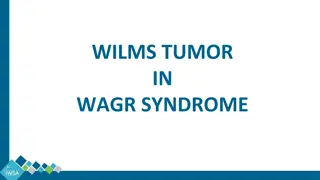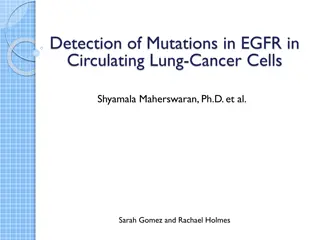Testicular carcinoma
The diagnosis and treatment options for testicular carcinoma from Dr. Shanzah Shahbaz, a medical oncologist. This comprehensive guide covers staging, tumor markers, false elevation risks, chemotherapy regimens, and management of residual masses.
2 views • 15 slides
[PDF] DOWNLOAD READ Diagnosis Solving the Most Baffling Medical Mysterie
\"[PDF] Download Diagnosis: Solving the Most Baffling Medical Mysteries Ebook | READ ONLINE\nDownload File => https:\/\/greatebook.club\/?book=0593136632\nDownload Diagnosis: Solving the Most Baffling Medical Mysteries read ebook Online PDF EPUB KINDLE\nDiagnosis: Solving the Most Baffling Medical M
3 views • 1 slides
Understanding Alinity i STAT High Sensitivity Troponin-I for Cardiovascular Diagnosis
Alinity i STAT High Sensitivity Troponin-I is a proprietary assay used in diagnosing myocardial infarction (MI) by quantitatively measuring cardiac troponin I in human plasma. This chemiluminescent microparticle immunoassay (CMIA) aids in the detection of MI, a significant aspect in managing heart d
2 views • 30 slides
Improving HER2 Targeting in NSCLC With Selective TKI
HER2 activation plays a crucial role in promoting tumor proliferation and survival in NSCLC. Driven by oncogenic downstream signaling pathways, HER2 overexpression and gene amplification lead to the formation of heterodimers and activation of key signaling cascades. Additionally, HER2 mutations are
0 views • 36 slides
Understanding Tumor Classification and Nomenclature in Pathology
This slideshow provides an overview of tumor classification, nomenclature, and key concepts in pathology. It covers the definitions of neoplasm, tumor, and oncology, the classification of tumors into benign and malignant categories, as well as the importance of stroma in tumor behavior. It also expl
1 views • 61 slides
Role and Challenges of PET Imaging in Proton Therapy
PET imaging plays a crucial role in proton therapy by aiding in range verification and monitoring treatment delivery. Proton therapy offers precise tumor targeting but is sensitive to uncertainties, making accurate imaging essential. Positron emitters generated during therapy can be detected using P
1 views • 17 slides
Pituitary Disorders
Pituitary disorders, often caused by tumors, can disrupt hormone production leading to various symptoms like weight gain, vision problems, and hormonal imbalances. The pituitary gland plays a crucial role in regulating bodily functions through hormone secretion. Factors such as tumor growth, head in
0 views • 25 slides
Comprehensive Spine Tumor Surgery at Medspine Hospital in Chennai
Discover the best spine tumor treatment at Medspine, the leading hospital with top surgeon and specialist in Medavakkam, Perumbakkam, Royapettah, Chennai.
3 views • 2 slides
Best Neurosurgery Hospitals in India
Neuro diseases are very bad diseases. Many people are caught by Neuro diseases nowadays. It is related to brain diseases. Many people in India are caught by Neuro Diseases. It happens in Adults as well as children.\nA person of any age can be affected by this. Before this time very bad disease Named
1 views • 2 slides
Preventing Spine Tumors_ Lifestyle Choices and Early Detection Methods
Discover the best spine tumor treatment at Medspine, the leading hospital with top surgeon and specialist in Medavakkam, Perumbakkam, Royapettah, Chennai.
8 views • 2 slides
Preventing Spine Tumors_ Lifestyle Choices and Early Detection Methods
Discover the best spine tumor treatment at Medspine, the leading hospital with top surgeon and specialist in Medavakkam, Perumbakkam, Royapettah, Chennai.
0 views • 2 slides
Overview of Acute Cholecystitis: Diagnosis, Severity Grading, and Treatment
Acute calculous cholecystitis is a common digestive disease with varying treatment perspectives. The Tokyo Guidelines 2018 provide criteria and severity grading for the diagnosis of acute cholecystitis. Diagnosis involves local and systemic signs of inflammation along with specific imaging findings.
0 views • 18 slides
Understanding CSF Rhinorrhea and Its Etiology
Cerebrospinal fluid (CSF) rhinorrhea is caused by an osseous defect at the skull base, leading to a leak due to disruption of the dura mater and arachnoid. Trauma and iatrogenic factors are common causes, with non-traumatic cases often linked to high-pressure leaks or tumor growth. Diagnosis involve
0 views • 8 slides
Understanding Grading and Staging of Malignant Tumors in Cancer Patients
Grading and staging are crucial in determining the aggressiveness and extent of malignant tumors. Grading involves assessing the level of malignancy based on cell differentiation and mitotic activity, while staging considers the size of the tumor, lymph node involvement, and presence of metastases.
7 views • 31 slides
28 Day Faster Diagnosis Standard in Cancer Services
The 28 Day Faster Diagnosis Standard focuses on timely referral to definitive diagnosis for suspected cancer patients, enabling prompt treatment initiation or providing peace of mind. Key principles include starting the clock upon receipt of referral and ending it upon diagnosis communication or tre
0 views • 7 slides
Molecularly-Guided Therapy vs Platinum Chemotherapy in CUP Patients
This trial aims to compare the efficacy and safety of molecularly-guided therapy or cancer immunotherapy based on genomic profiling with platinum-based chemotherapy in patients with cancer of unknown primary site. The study design includes multiple treatment regimens guided by genomic profiles, with
4 views • 9 slides
Understanding Wilms Tumor in WAGR Syndrome
WAGR syndrome is a rare genetic condition associated with Wilms Tumor, aniridia, and developmental delays. Wilms Tumor is a form of kidney cancer mostly affecting children and is linked to genetic disorders like WAGR syndrome. The risk of Wilms Tumor is higher in children with WAGR syndrome, with po
1 views • 14 slides
Neonatal Vomiting: Causes, Diagnosis, and Differential Diagnosis
Neonatal vomiting can be a concern when presenting with bile-stained or blood-stained vomit, projectile vomiting, or associated with weight loss and failure to grow. Various non-surgical and surgical conditions like Pyloric Stenosis can lead to vomiting in neonates. Common causes include Mid-gut vol
0 views • 16 slides
Laboratory Diagnosis of Fungal Infections: Specimen Collection and Transport
In the laboratory diagnosis of fungal infections, proper collection and transportation of specimens are crucial for accurate diagnosis and treatment. Different sites and types of specimens require specific collection techniques to avoid contamination and ensure viability. From superficial to systemi
0 views • 29 slides
Understanding Tetanus: Causes, Symptoms, and Diagnosis
Tetanus, also known as Locked Jaw or Saw Horse disease, is a highly fatal condition in domestic animals caused by the neurotoxin produced by Clostridium tetani. The disease is characterized by hyperaesthesia, tetany, and convulsions. Transmission occurs through contaminated soil, typically from hors
0 views • 10 slides
Clinical Diagnosis and Assessment of Pre-Labour Rupture of the Membranes
Pre-Labour Rupture of the Membranes (RROM) is characterized by the leakage of amniotic fluid before the onset of labor, particularly when the gestational age is less than 37 weeks. Clinical diagnosis involves a thorough history evaluation and examination, including sterile speculum examination to co
0 views • 18 slides
Dementia Recognition and Diagnosis in Primary Care Toolkit
This toolkit provides comprehensive information on dementia recognition and diagnosis in primary care settings. It covers the assessment process, clinical presentations, stages of diagnosis, and key questions for identifying cognitive decline. Images and descriptions enhance understanding of the too
0 views • 33 slides
Positron Emission Tomography: Applications in Society and Recent Developments
Positron Emission Tomography (PET) is a medical imaging technique focusing on metabolic differences in the body. By using positron-emitting radioisotopes, PET can detect how molecules are taken up by healthy and cancerous cells, aiding in accurate tumor localization with lower doses. The evolution o
0 views • 6 slides
Comprehensive Guidelines for Medullary Thyroid Carcinoma Management
Medullary thyroid carcinoma (MTC) is a rare neuroendocrine tumor that requires specialized management. This comprehensive guide covers the clinical presentation, diagnosis, genetic aspects, and detailed management strategies for MTC, including surgical options, follow-up evaluation, and systemic the
0 views • 123 slides
Comprehensive Overview of Parotid Tumor Diagnosis and Management
This comprehensive guide covers the diagnosis and management of parotid tumors, including anatomy, differential diagnosis, and management strategies. It discusses the approach to evaluating patients with neck lumps, differential diagnoses to consider, and the management techniques for both benign an
0 views • 20 slides
Combined Effect of Charged Particles Irradiation and Anticancer Drugs in Cultured Human Tumor Cells
Research collaboration aimed to enhance locoregional tumor control and reduce distant failure by combining charged particles irradiation and anticancer drug Epothilone B in cultured human tumor cells from Milano and Roma. The study explores the impact on clonogenic survival, growth curves, and deter
0 views • 13 slides
Understanding Fowl Pox in Avian Species: Causes, Symptoms, and Diagnosis
Fowl Pox, caused by Avipoxvirus, is a contagious disease in birds characterized by wart-like nodules and diphtheritic membranes in the throat and mouth. It has multiple forms, including dry pox, wet pox, and coryza-like form, with varying clinical signs. The disease spreads through mosquitoes, bitin
1 views • 10 slides
Radiology Case Presentation: Differential Diagnosis of Large Posterior Fossa Mass in 25-Year-Old Male
25-year-old male with persistent headaches and neck pain presents with worsening symptoms. Differential diagnosis includes primary brain tumor, pyogenic abscess, pilocytic astrocytoma, medulloblastoma, and other possibilities. Neurocysticercosis, a parasitic disease caused by T. solium, endemic in c
0 views • 18 slides
Understanding Gamma Knife Stereotactic Radiosurgery
The Gamma Knife Stereotactic Radiosurgery is a precise and effective treatment method where highly focused radiation beams are used to target tumors and abnormalities in the brain. It does not remove the tumor directly but affects DNA, cell growth, and blood vessels. The procedure involves three mai
0 views • 51 slides
NCI-MATCH Trial Interim Analysis Results and Status Update
NCI-MATCH is a groundbreaking clinical trial aiming to match tumor gene alterations with targeted therapies. The interim analysis results revealed impressive patient enrollment and site participation exceeding expectations. Despite challenges with pausing new patient registrations for the analysis,
0 views • 26 slides
Reflex Urine Culturing in UTI Diagnosis: Dos and Don'ts
Reflex urine culturing is a crucial diagnostic strategy for UTIs in hospitalized patients, emphasizing the importance of suspicion over urinalysis. Misuse can lead to increased positive cultures. Understanding the relevance to SPARC and focusing on diagnostic stewardship can help prevent unnecessary
0 views • 21 slides
Challenges Faced by Pregnant Women with HIV Diagnosis in Malawi
Maria, a pregnant woman in Malawi, faces the challenge of an unexpected pregnancy and a positive HIV diagnosis. The scenario explores her concerns, midwifery diagnosis, preparation for HIV testing, disclosure of results, and maintaining confidentiality in antenatal care. It also delves into factors
0 views • 10 slides
Detection of Mutations in EGFR in Circulating Lung Cancer Cells: Study on SARMS Assay and CTC-Chip
This study by Shyamala Maherswaran, Ph.D., and team focuses on characterizing mutations in EGFR in circulating tumor cells using SARMS assay and CTC-chip. The research investigates the effectiveness of these non-invasive methods in analyzing tumors and explores the role of the T790M mutation in resp
0 views • 12 slides
Immune Cell Analysis Supplementary Figures
This collection of supplementary figures provides detailed flow cytometry data on immune cell populations, including CD4+ T cells, CD8+ T cells, tumor-associated macrophages, and more. The figures also include information on immune checkpoint molecules like PD-L1 and TIGIT. Each figure presents spec
0 views • 4 slides
Understanding Acoustic Neuroma: Diagnosis and Management
Vestibular schwannoma, also known as acoustic neuroma, is a common tumor in the cerebellopontine angle. It can be sporadic or associated with neurofibromatosis type 2. Patients typically present with hearing loss and tinnitus, which may be gradual or sudden. Grading systems like Koos, Ojemann, and J
0 views • 75 slides
Overview of Immunohistochemistry (IHC) in Diagnostic and Research Laboratories
Immunohistochemistry (IHC) is a technique used to detect antigens in tissue sections by utilizing antibodies that bind specifically to target antigens. This method has evolved since the 1930s and plays a vital role in disease diagnosis, drug development, and biological research. IHC combines anatomi
0 views • 19 slides
Rare Case of Bilateral Undescended Testes with Intratubular Germ Cell Neoplasm in an Adult
A 35-year-old male presented with bilateral inguinal swelling and pain, revealing a rare case of synchronous bilateral intratubular germ cell neoplasm in bilateral undescended testes (cryptorchidism) in an adult. The pre-operative diagnosis was challenging due to the atypical tumor presentation. Ris
0 views • 25 slides
Understanding Neoplasia and Cancer: Key Concepts and Biological Aspects
Neoplasia encompasses abnormal tissue growth that can be benign or malignant. This article explores neoplastic terms, tumor classifications, cancer staging, and genetic factors in cancer development. Gain insights into the characteristics of benign tumors, the biology of cancer including carcinogene
0 views • 29 slides
Classification of Tumors: A Comprehensive Overview
Understanding the classification of tumors is crucial in the field of pathology. This detailed overview covers the definitions of neoplasia and tumors, the differentiation between benign and malignant tumors, nomenclature, and characteristics of various tumor types. It discusses the behaviors of ben
0 views • 34 slides
Anesthetic Management of Phaeochromocytoma: Key Issues and Strategies
Phaeochromocytoma, a neuroendocrine tumor of the adrenal medulla, presents unique challenges in anesthesia due to excessive catecholamine secretion. From clinical presentation to familial associations, this condition requires careful diagnosis and management to avoid complications during surgery. Un
0 views • 39 slides

![[PDF] DOWNLOAD READ Diagnosis Solving the Most Baffling Medical Mysterie](/thumb/9855/pdf-download-read-diagnosis-solving-the-most-baffling-medical-mysterie.jpg)





































